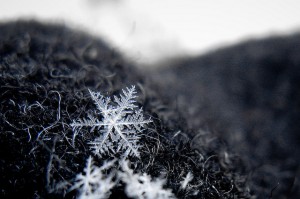 I love snow, but we don’t get much of it here. On the rare day that the highest peaks catch a few flakes, people pile into cars and drive up into our local mountains just to see a small patch of white.
I love snow, but we don’t get much of it here. On the rare day that the highest peaks catch a few flakes, people pile into cars and drive up into our local mountains just to see a small patch of white.
Part of the allure is the wonderful way in which snow is described —in Inuit, Yupik, Sami, and even in our own language. Sierra cement. Champagne powder. Cascade concrete. Alaskan velvet. Spring corn.
At close range, it’s more beautiful still. An avalanche forecaster once pointed to a photo of faceted snow crystals on her wall when I asked her what her favorite kind was. These weren’t her favorite, exactly—she said they’re the ones she loved to hate–but the ones that fascinated her, the kind that formed weak layers in the snow. (Here’s a cool animation of how it forms, usually with the help of a wide range of temperatures within the snowpack.)
Maybe it’s this combination of strong and weak that gets me. Snow crystals look like delicate formations of oxygen and hydrogen. Together, they can both create winter wonderlands and decimate landscapes and lives.
RadioLab did a recent story about snowflakes, and how they’re just as beautiful, but perhaps not as perfect, as we might have thought. This comes as a relief, as the only kinds of snowflakes that stick around here are ones made of paper, and mine are always far from perfect.
But now, my homemade snowflakes are starting to be much more interesting, thanks to a woman who once dubbed herself a “recreational mathmusician”.
Last week I learned about Vi Hart, now a professional mathmusician at Khan Academy, who has been making cool videos about math for the past few years. She’s tackled everything from hexaflexagons to a mathematically-interesting Thanksgiving turducken with a “fractal fowl arrangement,” using a combination of Sharpies, stick figures, and fast-paced narration.
Here’s how she makes snow and other flakes—some of them even have rotational symmetry.
In order to create my in-house snowstorm, I’ve been watching this video over and over again to let my brain catch up to these flying scissors.
But after a while, something starts to click. Paper or precipitation, snowflakes and their symmetry seem to transport me out of the transient clutter that surrounds me. And then, once the snow has melted—whether I’ve seen it on skis or in the bobsled courses of my imagination—the world seems a bit more perfectly imperfect than it was before.
**
Image Pen Weggener Video Vi Hart